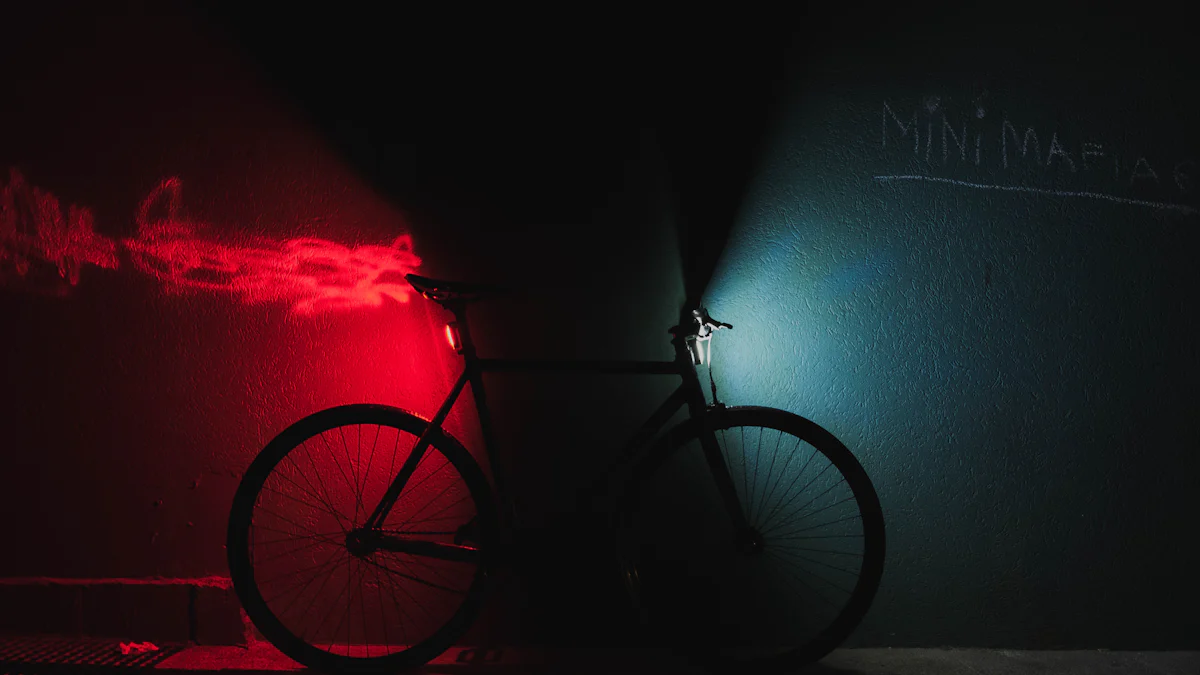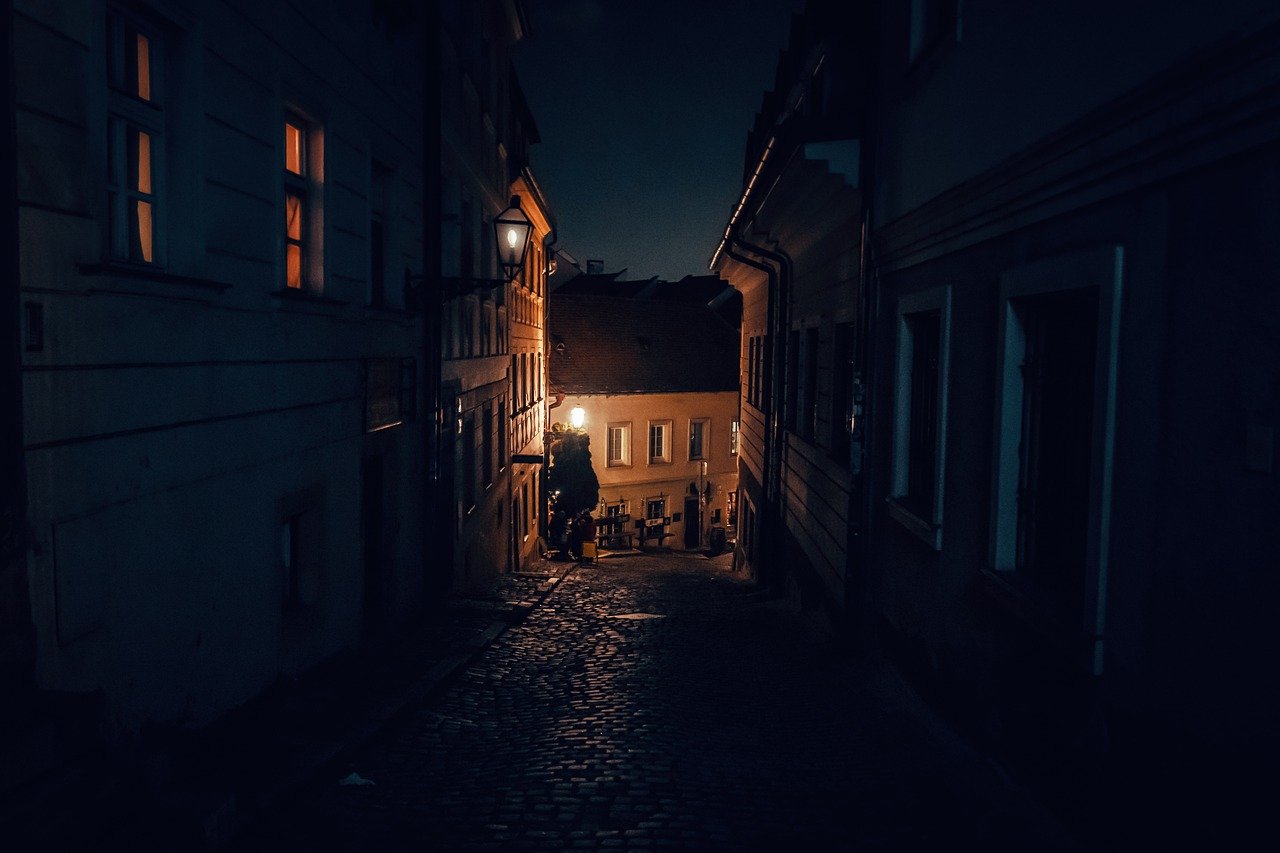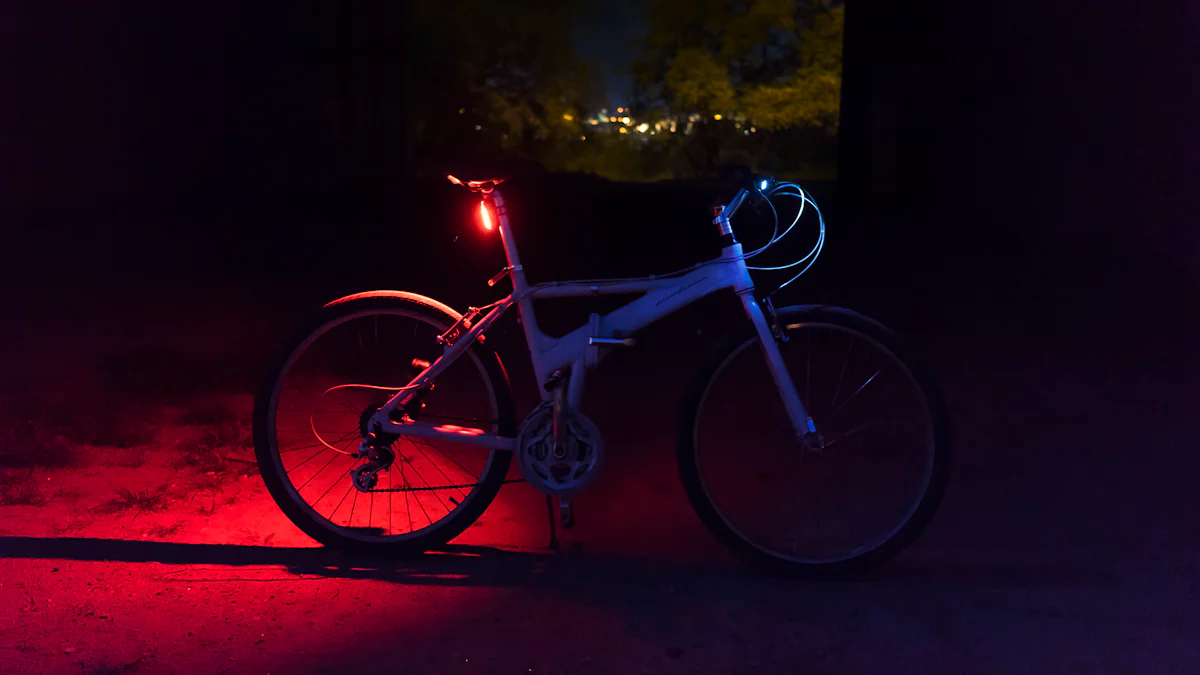How to Choose the Best Flashlight for Nighttime Running or Cycling

Running or cycling at night can be thrilling, but it comes with challenges. You need the best flashlight to stay safe and visible. A good flashlight for running ensures you see obstacles clearly and stay confident. Look for one with excellent brightness and reliable performance to make your nighttime adventures enjoyable.
Key Takeaways
Pick a flashlight with 250-500 lumens for running. Use 800+ lumens for cycling in dark areas. This helps you see obstacles and stay visible to others.
Find lightweight, strong flashlights that resist water. They are easy to carry and work well in bad weather.
Try headlamps for running and lights on bike handles for cycling. These give hands-free use and better visibility.
Why You Need a Flashlight for Running or Bike Lights for Cycling
Enhancing Safety and Visibility
Running or biking at night can be risky without proper lighting. A flashlight or bike light makes you visible to others and helps you see your surroundings clearly. Studies show that using lights can significantly reduce accidents. For example:
A Danish study found that all-day bike lights reduced crashes by 30 to 50 percent.
The U.S. Department of Transportation reported a 7.9 percent drop in daytime collisions for vehicles with running lights.
Motorcycle-car collisions decreased by 26 percent when motorcycles used lights.
These statistics highlight how essential visibility is for your safety. Whether you're running on a dimly lit trail or cycling through busy streets, a reliable light ensures you're seen and protected.
Avoiding Obstacles and Hazards
Nighttime activities come with hidden dangers. Uneven sidewalks, potholes, or unexpected debris can cause accidents. A flashlight illuminates your path, helping you avoid these hazards. For cyclists, bike lights mounted on handlebars provide a steady beam to spot obstacles ahead. This added visibility keeps you in control and reduces the chances of injury.
Boosting Confidence and Performance
Feeling safe and visible can transform your nighttime workout. When you know drivers and pedestrians can see you, you feel more confident. This confidence allows you to focus on your pace and performance. Research supports this idea. A 2012 study found that reflective clothing improved recognition distances for pedestrians by up to 300 meters. The same principle applies to lights. Being visible reduces stress, letting you enjoy your run or ride without constant worry.
Evidence Type | Description |
|---|---|
Study | A 2012 study published in the Journal of Safety Research found that reflective clothing improved recognition distances for pedestrians by up to 300 meters. |
Visibility Impact | Wearing reflective gear gives drivers more time to react, enhancing safety for runners and cyclists. |
Performance Boost | Knowing they are visible allows runners to focus on their performance, reducing stress and improving their workout experience. |
With the right flashlight or bike light, you can tackle nighttime running or biking with ease and confidence.
Key Features of the Best Flashlight for Running or Cycling

Brightness and Lumens
When choosing a flashlight, brightness is one of the most important factors. You’ll often see brightness measured in lumens, which indicates how much light the flashlight emits. For nighttime running or cycling, the right lumen range depends on your activity and environment.
Here’s a quick guide to help you decide:
Activity Type | Front Light Lumens | Rear Light Lumens |
|---|---|---|
Urban Commuting | 250 to 500 | 100–200 (flashing) |
Road Cycling | 400-600 (well-lit) | 200 (flashing) |
800+ (poorly lit) | ||
E-Bikes | 500-1000 | 200-400 (flashing) |
Mountain Biking | 800 to 1500 | 200–300 |
Gravel Riding | 500-1000 | 150-250 |
For runners, a flashlight with 250–500 lumens is usually sufficient. Cyclists, especially those riding in poorly lit areas, may need high lumen lights of 800 or more for maximum visibility.
Battery Life and Rechargeability
You don’t want your flashlight dying mid-run or ride. Look for one with a long battery life that matches your activity duration. Rechargeable batteries are a great option. They’re eco-friendly and save you money in the long run. Some flashlights even have battery indicators, so you’ll know when it’s time to recharge.
Weight and Portability
A heavy flashlight can slow you down. For runners, lightweight options that clip onto your clothing or fit comfortably in your hand are ideal. Cyclists should look for compact lights that don’t add unnecessary bulk to their handlebars or helmets.
Durability and Water Resistance
Your flashlight needs to withstand tough conditions. Materials like aluminum and plastic are commonly used. Aluminum offers a premium feel and better heat dissipation, while plastic absorbs shocks more effectively.
Material | Durability Characteristics | Notes |
|---|---|---|
Aluminum | Less shock absorbent, can deform permanently under stress | Used in high-quality flashlights for premium feel and heat dissipation |
Plastic | Absorbs shock better, less prone to permanent deformation | More stable over time, but can melt under extreme temperatures |
Also, check the IP rating for water resistance. For example:
IP65: Water-resistant against low-pressure water jets.
IP67: Can handle submersion in up to 1 meter of water for 30 minutes.
IP68: Dustproof and suitable for continuous submersion in deeper water.
Beam Type and Light Color
The beam type affects how the light spreads. A wide beam is great for runners who need to see their surroundings, while a focused beam works well for cyclists who need to see far ahead. Some flashlights also offer adjustable beams for versatility. As for light color, white light is the most common, but red light can preserve night vision and reduce glare.
Mounting Options for Runners and Cyclists
How you carry or mount your flashlight matters. Runners might prefer headlamps or clip-on lights for hands-free convenience. Cyclists should look for handlebar-mounted lights or helmet-mounted options for better control and visibility. Make sure the mounting system is secure and easy to adjust.
Comparing Flashlight Types for Nighttime Activities

Headlamps for Running
A headlamp is a fantastic choice for runners who want hands-free lighting. It sits comfortably on your forehead, directing light wherever you look. This makes it perfect for illuminating uneven trails or dark sidewalks. Many headlamps come with adjustable brightness settings, so you can conserve battery life when needed. For example, some models, like the Nathan hand torches, offer a 24-degree angle of light, focusing illumination on the ground ahead. They even include a rear strobe light for added visibility, which is great for staying safe in low-light conditions.
However, headlamps aren’t without drawbacks. The strobe light can distract runners behind you, and the alarm button on some designs is too close to the power switch, leading to accidental activations. Despite these minor issues, a headlamp remains one of the most practical tools for nighttime running.
Handlebar-Mounted Bike Lights
If you’re a cyclist, handlebar-mounted lights are a game-changer. These lights are specifically designed to distribute light optimally, ensuring you see the road clearly. Unlike generic flashlights, they enhance safety by providing a steady beam tailored for cycling. Their robust mounting systems keep them secure, even on bumpy rides. This durability makes them a reliable choice for daily use.
Some cyclists might think handlebar lights are unnecessary, but their benefits are hard to ignore. They improve visibility and make your rides safer and more enjoyable. Whether you’re commuting or exploring trails, these lights are worth the investment.
Handheld Flashlights for Versatility
Handheld flashlights are the most versatile option for nighttime activities. They’re not just for running or cycling—they’re also great for camping, hiking, or emergencies. A good flashlight can help you navigate dark environments with confidence. Many users even rely on tactical flashlights to deter intruders or signal for help.
While handheld flashlights offer flexibility, they do require you to hold them, which might not be ideal for runners or cyclists. Still, their reliability and multi-purpose nature make them a valuable addition to your gear.
Tips for Maintaining and Using Your Flashlight
Cleaning and Maintenance
Keeping your flashlight in top shape ensures it works when you need it most. Regular cleaning is key. Start by wiping down the exterior to remove dirt and grime. For the interior, clean the battery compartment to keep it running smoothly. If you notice corroded battery contacts, use a vinegar solution to clean them safely.
Don’t forget to check the O-rings and seals. These small parts prevent water from getting inside. If they’re damaged, replace them to maintain water resistance. You can even test the flashlight’s water resistance by submerging it briefly in water. Just make sure to dry it thoroughly afterward to avoid internal damage. Setting up a maintenance schedule—monthly or bi-yearly—can help you stay on top of these tasks.
Battery Care and Replacement
Your flashlight’s runtime depends heavily on how you care for its batteries. Always fully charge rechargeable batteries before using them. Avoid exposing them to extreme heat or cold, as this can shorten their lifespan. When storing your flashlight, keep it in a cool, dry place. If you won’t be using it for a while, remove the batteries to prevent leaks.
Using high-quality batteries from trusted brands can also make a big difference. Recharge your batteries when they’re low, but don’t let them drain completely. And remember to unplug the flashlight as soon as it’s fully charged to avoid overcharging. These small steps can extend your battery runtime and keep your flashlight ready for action.
Adjusting Settings for Different Conditions
Modern flashlights often come with adjustable settings, and learning how to use them can make a big difference. For example, a lower brightness setting can conserve battery life during long runs or rides. If you’re in a foggy area, switching to a red light mode can improve visibility without creating glare.
Experiment with the beam type as well. A wide beam works great for running on trails, while a focused beam is better for cycling at higher speeds. Adjusting these settings based on your environment ensures you get the best performance from your flashlight every time.
Recommendations for Specific Use Cases
Best Flashlight for Running
When it comes to running at night, you need a flashlight that’s lightweight, bright, and easy to carry. A headlamp is often the best choice because it keeps your hands free and directs light wherever you look. Look for one with adjustable brightness settings and a comfortable strap. For example, the Black Diamond Spot 400-R is a popular option. It offers 400 lumens of brightness, a rechargeable battery, and a compact design that won’t weigh you down.
If you prefer a handheld flashlight for running, consider the Fenix PD25R. It’s small, powerful, and fits comfortably in your hand. With 800 lumens and a rechargeable battery, it’s perfect for illuminating dark trails or sidewalks. Whichever option you choose, make sure it provides enough light to keep you safe and visible.
Best Bike Lights for Cyclists
Cyclists need reliable bike lights to navigate roads and trails safely. A good front light ensures you can see obstacles ahead, while a rear light makes you visible to others. Here’s a quick comparison of some top-rated options:
Model | Max Output (lumen) | Runtime (hours) | Charge Port | Price (USD) | Highs | Lows |
|---|---|---|---|---|---|---|
PDW Pathfinder USB | 400 | 2 | Micro-USB | $37.99 | Compact, lightweight, extended runtime | Lower output for dark trails |
Cygolite Ranger 2000 | 2000 | 1.5 | USB | $119.92 | Extremely powerful, long battery life | Bulky, limiting under-computer mounting |
Knog Blinder 1300 | 1300 | 1.5 | USB-C | $99.95 | Excellent brightness, versatile mounting options | Short runtime on highest setting |
Blackburn Dayblazer 550 | 550 | 1 | USB-C | $40.00 | Compact, easy to mount | Short battery life in high mode |
For urban commuting, the PDW Pathfinder USB is a great choice. It’s compact and affordable, with enough brightness for city streets. If you’re tackling darker trails, the Cygolite Ranger 2000 offers unmatched power and long battery life.
Budget-Friendly Options
You don’t have to spend a fortune to get a reliable flashlight for running or bike lights. For runners, the Energizer Vision HD+ Focus Headlamp is a solid pick. It costs under $20, provides 400 lumens, and has a comfortable fit. Cyclists can check out the Specialized Flash 300 Headlight. At just $34.99, it delivers 300 lumens and a sleek design, making it perfect for casual rides.
If you’re looking for a versatile option, the Ravemen FR160 Bike Headlight doubles as a flashlight and bike light. It’s lightweight, USB-C rechargeable, and costs only $36.95. These budget-friendly options prove you don’t need to break the bank to stay safe and visible at night.
Choosing the right flashlight can make all the difference in your nighttime adventures. Focus on brightness, battery life, and mounting options to match your needs. Look for durable, lightweight designs with a waterproof rating for added reliability. A tailored flashlight keeps you safe, visible, and confident. Invest in quality—it’s worth it!
FAQ
What’s the ideal brightness for nighttime running or cycling?
For running, 250–500 lumens works well. Cyclists need 800+ lumens for poorly lit areas. Choose brightness based on your activity and environment.
Can I use a regular flashlight for cycling?
You can, but it’s not ideal. Bike-specific lights offer better mounting, beam focus, and stability for safer rides. Regular flashlights lack these features.
💡 Tip: Invest in a handlebar-mounted light for cycling. It’s safer and more convenient!
How do I maintain my flashlight’s battery life?
Fully charge rechargeable batteries before use. Avoid extreme temperatures. Store in a cool, dry place. Remove batteries during long storage to prevent leaks.
🔋 Pro Tip: Use high-quality batteries for better performance and longer runtime!
See Also
Selecting The Perfect Headlamp Flashlight For Your Needs
Finding The Best Rechargeable Flashlight For Hiking Adventures
Essential Tips For Selecting A Flashlight For Backcountry Hiking
